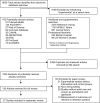Interventions that affect gender bias in hiring: a systematic review
- PMID: 19881440
- PMCID: PMC4554714
- DOI: 10.1097/ACM.0b013e3181b6ba00
Interventions that affect gender bias in hiring: a systematic review
Abstract
Purpose: To systematically review experimental evidence for interventions mitigating gender bias in employment. Unconscious endorsement of gender stereotypes can undermine academic medicine's commitment to gender equity.
Method: The authors performed electronic and hand searches for randomized controlled studies since 1973 of interventions that affect gender differences in evaluation of job applicants. Twenty-seven studies met all inclusion criteria. Interventions fell into three categories: application information, applicant features, and rating conditions.
Results: The studies identified gender bias as the difference in ratings or perceptions of men and women with identical qualifications. Studies reaffirmed negative bias against women being evaluated for positions traditionally or predominantly held by men (male sex-typed jobs). The assessments of male and female raters rarely differed. Interventions that provided raters with clear evidence of job-relevant competencies were effective. However, clearly competent women were rated lower than equivalent men for male sex-typed jobs unless evidence of communal qualities was also provided. A commitment to the value of credentials before review of applicants and women's presence at above 25% of the applicant pool eliminated bias against women. Two studies found unconscious resistance to "antibias" training, which could be overcome with distraction or an intervening task. Explicit employment equity policies and an attractive appearance benefited men more than women, whereas repeated employment gaps were more detrimental to men. Masculine-scented perfume favored the hiring of both sexes. Negative bias occurred against women who expressed anger or who were perceived as self-promoting.
Conclusions: High-level evidence exists for strategies to mitigate gender bias in hiring.
Figures
References
-
- National Institutes of Health [June 29, 2008];Changing the Face of Medicine Web site. Available at: ( http://www.nlm.nih.gov/changingthefaceofmedicine).
-
- Wright AL, Schwindt LA, Bassford TL, et al. Gender differences in academic advancement: Patterns, causes, and potential solutions in one US college of medicine. Acad Med. 2003;78:500–508. - PubMed
-
- Ash AS, Carr PL, Goldstein R, Friedman RH. Compensation and advancement of women in academic medicine: Is there equity? Ann Intern Med. 2004;141:205–212. - PubMed
-
- Strauss SE, Richardson WS, Glaziou P, Haynes RB. Evidence-based Medicine: How to Practice and Teach EBM. 3rd ed. Churchill Livingstone; Edinburgh, UK: 2005.
Publication types
MeSH terms
Grants and funding
LinkOut - more resources
Full Text Sources
Miscellaneous


